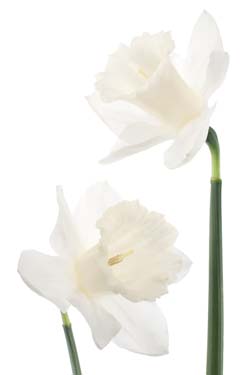 Daffodils are the harbingers of spring. Plant yours now for a glorious display.
Daffodils are the harbingers of spring. Plant yours now for a glorious display.
When choosing bulbs, big is best. Smaller bulbs may not flower the first season. The bulbs should be clean and free from any blemishes, too, or you may find they’ll do nothing but rot. Feel them to ensure there are no soft spots.
 Daffodil bulbs are best planted when the soil has cooled – around 15-17 degrees C. Look to the weather page of your local newspaper to see temperatures. That’s usually April to May in the southern hemisphere. The soil must be free-draining or the bulbs may rot.
Daffodil bulbs are best planted when the soil has cooled – around 15-17 degrees C. Look to the weather page of your local newspaper to see temperatures. That’s usually April to May in the southern hemisphere. The soil must be free-draining or the bulbs may rot.
Plant in full sun – daffodils must have light to flower well. Though you can plant them under deciduous trees, as much of their growth is completed before the trees fully leaf out.
Add a commercial bulb fertiliser – one that’s high in potassium and low in nitrogen – to the soil at planting time, then fertilise once or twice more during the growing season. You don’t need to overdo the fertilising at this stage – your daffodils are actually drawing much of their nutrients from the bulb, the nutrients having been stored in the bulb from the last growing season.
After flowering, the bulbs begin to store food for the following season, so this is an important time to feed and water. Remove the spent flower heads and stems but leave the foliage to die down naturally. It’s during this time that all the nutrients contained within the foliage are transferred to the bulbs. Fertilise once or twice more and continue to water until the leaves wither and turn brown. If the leaves are removed when still green, flowering may be reduced the following season.
Planting in containers
 Plant in a deep pot rather than a shallow bowl as daffodil roots go reasonably deep. Make sure the potting mix is free-draining – a good-quality bulb mixture is ideal. It should contain a slow-release fertiliser to cater for the bulbs’ needs right through to flowering and beyond.
Plant in a deep pot rather than a shallow bowl as daffodil roots go reasonably deep. Make sure the potting mix is free-draining – a good-quality bulb mixture is ideal. It should contain a slow-release fertiliser to cater for the bulbs’ needs right through to flowering and beyond.
Bulbs grown in pots can be planted closer together than those planted in the ground, as you can easily repot them each season. To get the most in your pot, plant two layers, one beneath the other but staggered. The bulbs on the bottom layer will shoot up in between the bulbs on the top layer. In a 30cm pot, you can get 12 bulbs – 6 bulbs for each layer.
Keep freshly planted pots in a cool shady spot while roots are developing, then move them into the light when shoots appear. While roots are developing, keep watering to a minimum. When you bring your container into sunlight, water more frequently. Check soil moisture daily, watering just enough to keep the soil moist but not soggy.
No flowers?
If long-planted daffodils fail to bloom, or numbers diminish, the bulbs may be overcrowded. Dig them up when they’re dormant (November/December is a good time in the southern hemisphere), set them aside to dry for a couple of weeks, then remove the offsets. Store in a dry, airy place in a mesh bag or plastic bulb basket – something that allows air to pass through. Watch for aphid infestation during storage. You can keep them at bay by spraying with aerosol Confidor or even fly spray. Spray after lifting, then monthly to keep them clear.
Displaying your daffodils in a vase
 When picking daffodils for the vase, watch out for the white sap that exudes from the stems. The sticky substance is a skin irritant, and can cause a rash. That white sap is also toxic to other flowers in the vase. To mix daffodils with other flowers in a vase, you’ll need to condition your daffodils first. Place the cut daffodils in a vase with 3cm of cool water. Add sugar or floral preserve. After a few hours the daffodils will have gulped up all the water. At this stage, you can display your daffodils in a vase if you only want to use daffodils. If mixing your daffodils with other flowers, rinse the vase and add fresh water. After 6-8 hours, you can then place your daffs in a vase with other flowers.
When picking daffodils for the vase, watch out for the white sap that exudes from the stems. The sticky substance is a skin irritant, and can cause a rash. That white sap is also toxic to other flowers in the vase. To mix daffodils with other flowers in a vase, you’ll need to condition your daffodils first. Place the cut daffodils in a vase with 3cm of cool water. Add sugar or floral preserve. After a few hours the daffodils will have gulped up all the water. At this stage, you can display your daffodils in a vase if you only want to use daffodils. If mixing your daffodils with other flowers, rinse the vase and add fresh water. After 6-8 hours, you can then place your daffs in a vase with other flowers.
 My Favourites
My Favourites










Speak Your Mind